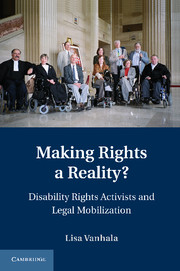Book contents
- Frontmatter
- Contents
- List of Figure and Tables
- Acknowledgments
- Abbreviations
- 1 Introduction: Legal Mobilization and Accommodating Social Movements
- 2 Rights and Political Identity in the Canadian Disability Movement
- 3 Disability Equality and Opportunity in the Supreme Court of Canada
- 4 Disability Organizations and the Diffusion of Rights in the United Kingdom
- 5 Framing Disability Equality in the UK Courts
- 6 Conclusions: Litigation, Mobilization, and Social Movements
- Bibliography
- Index
4 - Disability Organizations and the Diffusion of Rights in the United Kingdom
Published online by Cambridge University Press: 03 May 2011
- Frontmatter
- Contents
- List of Figure and Tables
- Acknowledgments
- Abbreviations
- 1 Introduction: Legal Mobilization and Accommodating Social Movements
- 2 Rights and Political Identity in the Canadian Disability Movement
- 3 Disability Equality and Opportunity in the Supreme Court of Canada
- 4 Disability Organizations and the Diffusion of Rights in the United Kingdom
- 5 Framing Disability Equality in the UK Courts
- 6 Conclusions: Litigation, Mobilization, and Social Movements
- Bibliography
- Index
Summary
INTRODUCTION
This chapter paints a picture of the disability community in the United Kingdom and explains how disability organizations have approached the opportunity to undertake legal mobilization as part of their strategies to influence public policy. I provide a brief overview of the history of three main types of organizations that have operated in the sphere of disability policy from the 1970s to 2005: the grassroots organizations of disabled persons; the traditional disability charities; and a quasi-nongovernmental organization, the Disability Rights Commission (DRC). I explore the evolving attitudes within and across organizations toward social model understandings of disability and also their attitudes toward, and (where relevant) their usage of, strategic litigation as a policy-influencing tool. The analysis in this chapter demonstrates that there is significant variation, both among and within, the three types of organizations in the disability sector in the UK regarding the use of (and organizational values on the use of) strategic litigation. This is in contrast to Canada, where the majority of the main disability organizations have turned to the courts. Included in the sample of organizations chosen there are cases of important disability organizations that have not adopted the use of litigation. This allows for the exploration of some “negative cases”: groups that have not used (or in some cases, even considered using) legal action to pursue policy goals.
- Type
- Chapter
- Information
- Making Rights a Reality?Disability Rights Activists and Legal Mobilization, pp. 146 - 202Publisher: Cambridge University PressPrint publication year: 2010



